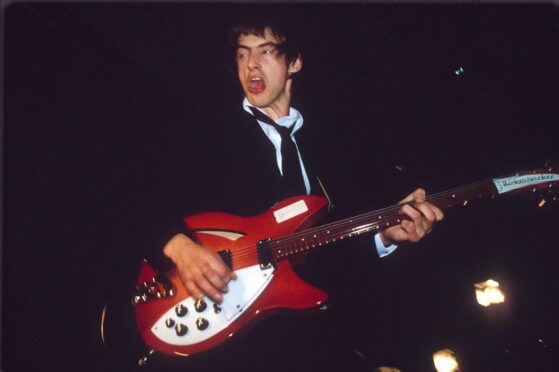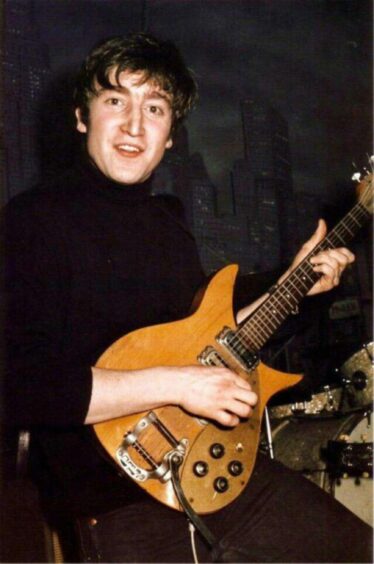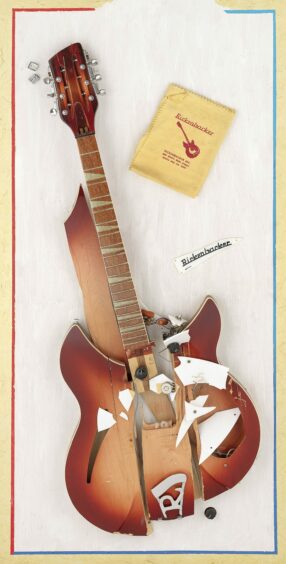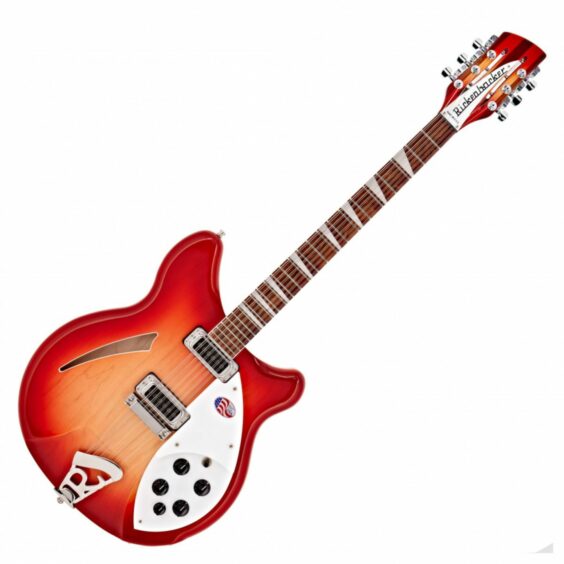
It’s 1960 and a young English rocker is buying an American guitar in a German music store and about to change everything.
John Lennon’s Rickenbacker 325, a 1958 Capri, would, one way or another, reverberate around the world as the company’s guitars, distinctive in sound and look, became as famous as the superstars who loved them.
From The Beatles and The Jam to Motörhead and The Byrds, Rickenbackers would soundtrack the coming decades and music executive Martin Kelly easily understands why.
“They’re just so iconic,” he said. “Maybe they’re not everyone’s cup of tea to play but there’s no questioning their beauty.”
He and his director brother Paul devoted months of their lives to creating a detailed and gloriously illustrated history of Rickenbackers. Fender’s Stratocaster and Gibson’s Les Paul may be the most recognisable electric guitars out there but the Rickenbacker holds a special place in the hearts of many musicians searching for something a little different.
With their hand-carved bodies, Rickenbackers, offered in six and 12-string varieties, are at the luxury end of the market and the Kelly brothers – who made two road trips to the USA to meet hardcore collectors including one obsessive who owns 360 Rickenbackers – explain how they left their indelible mark on rock.
Martin says: “When the Beatles went to Germany in 1960, John Lennon found his Rickenbacker 325 in a music store. It was one of only 14 Rickenbackers in the country so it was a great find.
“Lennon took a relaxed attitude to the matter of payment. He signed a credit deal and made the first payment,” explains Martin, “and then never went back to the shop.”
Seeing the value in having the biggest pop group in the world play their guitars, Rickenbacker executives presented The Beatles with two more models during the band’s first trip to New York. One of those was the 12-string guitar – its distinctive jangle created by the pairing of each string with one an octave higher – that George Harrison used on a run of hit singles. And once Harrison started playing a Rickenbacker, other guitarists soon followed.
“The story goes that the members of The Byrds went to see A Hard Day’s Night and after the screening they were outside the cinema, David Crosby’s swinging round a lamppost saying that’s what they should be doing and the lead guitarist Roger McGuinn went and bought a 12-string Rickenbacker,” explains Martin.
McGuinn’s unmistakable chiming guitar soon adorned a series of hits, including Mr Tambourine Man, Eight Miles High, and Turn Turn Turn. But, while McGuinn and his fellow folk-rockers cherished the Rickenbacker for its crystal-clear jangle, another young player was wringing an entirely different sound from his guitars. The Who’s Pete Townshend’s use of Rickenbacker 330s made them the guitar of choice for sixties mod groups.
Townshend distorted the sound of his guitar to create raucous classics like My Generation but the Rickenbacker was more than just an instrument to Townshend – it was also a dramatic stage prop. The Who’s guitarist was often photographed destroying his guitars during live shows.
One of the most striking images in the Kelly brothers’ book shows a young Townshend sitting on his bed, the wall behind him adorned with broken Rickenbackers.
“What a defiant statement,” says Martin. “These were the most expensive guitars on the market and Townshend’s sitting in front of broken guitars that would have cost someone two-and-a-half years’ wages at the time.”
As the sixties tipped into the seventies and guitar bands sought a heavier sound, Rickenbacker fell out of fashion. But, while guitars became less common on stages around the world, the company’s electric basses became hugely popular, used by bands as diverse as epic rockers Rush, punk legends The Sex Pistols, and heavy metal superstars Motörhead, whose singer Lemmy used the instruments throughout his career.
Just as a young British guitarist, George Harrison, was behind the brand’s first wave of popularity, it was to be a countryman who would help revive it. Paul Weller of The Jam, inspired by the mod look of Pete Townshend, was rarely seen without a Rickenbacker 330, while the band’s bassist, Bruce Foxton, would often play a matching bass.
At the same time, across the Atlantic, Tom Petty was bringing back that 12-string jangle. “It was Paul Weller who put the guitars back on the map,” says Martin, “And, after that, young guitarists like Peter Buck from R.E.M., Johnny Marr from The Smiths, and Susanna Hoffs from The Bangles started using them. At that time, people were looking back to the sixties for inspiration and Rickenbackers had this appeal.”
Soon Rickenbacker were resurgent in the late-80s and early-90s UK indie scene, of which Martin and Paul were part with their band East Village, with players such as Brix Smith from The Fall and Andy Bell from Ride making them the must-have guitars of the time.
Martin recalls: “There were quite a few bands using Rickenbackers, then. I think the most prominent was Jim Beattie from Primal Scream, whose 12-string playing was brilliant.”
Beattie left Primal Scream after their first album, Sonic Flower Groove, and the band went on to make albums influenced by dance music and classic Rolling Stones-style rock’n’roll but that first record is a jangly homage to the sound of The Byrds.
Does Martin thinks it’s coincidence that British guitarists have been so influential in the history of this particular American guitar company?
“There’s definitely something there,” he says. “The man who designed the classic Rickenbackers was a German called Roger Rossmeisl and they have a European aesthetic. It’s easy to see the appeal to British players.”
Teenage Fanclub frontman Norman Blake is a long-time fan of the Rickenbacker sound and his band owns a 325 model similar to John Lennon’s. “It has a very distinctive sound, a really great sound. We used it a lot on our album, Howdy. The guitar was made in the mid-80s so it’s vintage now.”
Blake’s friend and frequent collaborator, Duglas Stewart of BMX Bandits is another big fan of the 12-string. “My favourite Rickenbacker song is a Byrds one, Chestnut Mare,” he said. “It was originally meant to be part of a far-out country-rock musical but the musical never happened. I like how it is this fantastical wild-west tale but it has at the heart of it Roger McGuinn’s chiming Rickenbacker. It ended up in the UK top 20.”
While fashions come and go, Martin is certain the Rickenbacker’s status as a classic is assured. “Susanna Hoffs once said they were like Picassos and I think that’s right.”
Owning the same guitar as Johnny Marr was, sadly, not enough to make me sound like Johnny Marr
It was the most beautiful guitar – possibly the most beautiful thing – I’d ever seen. When they opened the case in the shop, it took my breath away, writes Euan McColm.
It had cost me two guitars plus £400 and now it was mine, a Rickenbacker 360/12 in a warm fireglo finish.
I’d been obsessed, throughout my 1980s teens, with the guitar playing of both Johnny Marr and Roger McGuinn. I knew every Smiths and every Byrds record back to front and when I began playing guitar, it was inevitable I’d covet a Rickenbacker.
Instead, I started with a copy of a Fender Stratocaster, a cheap, shoddy lump of wood and metal that would not stay in tune. A series of slightly better but still basically second-rate guitars followed.
The receipt of money on my 21st birthday changed all that. I lay in my bedsit that night and gazed lovingly at it, propped against a curtain. I did a lot of revering that guitar. But I didn’t really play it.
The thing that I hadn’t really considered was that the Rickenbacker sound I so adored on countless records was not entirely down to the instruments themselves. There was also the not-insignificant-matter of the incredible talent of the players.
Simply owning the same guitar as Johnny Marr was not, sadly, enough to make me sound like Johnny Marr. I fumbled and stumbled along with the guitar for a couple of years and it was almost a relief when financial necessity required its sale.
With the proceeds, I saw off eviction and bought a battered old Fender Mustang more suited to what I’m going to describe as my primitive style of playing. But, of course, I think back with regret about that Rickenbacker. Could we have worked things out? If we’d spent the past 30 years together, would I have been able to wring music of such chiming beauty from it that friends would have urged me to play for them?
Perhaps, I think. Perhaps. And then I catch a grip of myself. No. The answer is no.
It’s only rick’n’roll
Writer and guitarist Euan McColm chooses a few Rickenbacker classics.
Mr Tambourine Man – The Byrds
Roger McGuinn’s chiming 12-string guitar intro remains perhaps the most famous Rickenbacker moment in musical history.
If I Needed Someone – The Beatles
George Harrison’s guitar sparkles throughout this gem from Rubber Soul.
Ace of Spades – Motörhead
Frontman Lemmy’s Rickenbacker bass riff is instantly recognisable. Time cannot diminish its power.
Hero Takes A Fall – The Bangles
Singer Susanna Hoffs drives this early hit with some great rhythm playing on her solid-bodied Rickenbacker 350.
Velocity Girl – Primal Scream
Originally a B-side in 1986, Velocity Girl went on to become an indie classic. Before lockdown, guitarist Jim Beattie reunited with the band to play it at Glasgow’s Barrowland.
Rickenbacker Guitars: Out Of The Frying Pan Into The Fireglo phantombooks.com

Enjoy the convenience of having The Sunday Post delivered as a digital ePaper straight to your smartphone, tablet or computer.
Subscribe for only £5.49 a month and enjoy all the benefits of the printed paper as a digital replica.
Subscribe

